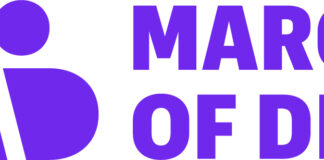U.S. Preterm Birth Rate Hits Healthy People 2020 Goal Seven Years Early
Nation Still Earns a “C” on
March of Dimes Annual Premature Birth Report Card
WHITE PLAINS, N.Y., Nov. 6, 2014 /PRNewswire/ — The national preterm birth rate fell to 11.4 percent in 2013 – the lowest in 17 years – meeting the federal Healthy People 2020 goal seven years early. Despite this progress, the U.S. still received a “C” on the 7th annual March of Dimes Premature Birth Report Card because it fell short of the more-challenging 9.6 percent target set by the March of Dimes, the group said today.
To view the multimedia assets associated with this release, please click: http://www.multivu.com/players/English/65164-march-of-dimes-march-for-babies-2014/
Photo – http://photos.prnewswire.com/prnh/20141105/156902
“Achieving the Healthy People 2020 goal is reason for celebration, but the U.S. still has one of the highest rates of preterm birth of any high resource country and we must change that,” said March of Dimes President Dr. Jennifer L. Howse. “We are investing in a network of five prematurity research centers to find solutions to this still too-common, costly, and serious problem.”
More than 450,000 babies were born premature in 2013, compared to 542,893 in 2006 when the rate was at its highest. The March of Dimes estimates that since 2006, 231,000 fewer babies have been born preterm because of sustained interventions put in place by states, saving $11.9 billion in healthcare and other costs. Medical expenses for an average premature infant are about $54,000 compared to just $4,000 for a healthy newborn.
The sustained improvement in reducing premature births shows that when infant health becomes a priority, babies benefit. Bold leadership and policies implemented by state and local health departments, hospitals and health care providers will encourage continued health improvements for newborns, Dr. Howse added.
Preterm birth is the leading cause of newborn death, and babies who survive an early birth often face serious and sometimes lifelong health challenges, such as breathing problems, jaundice, developmental delays, vision loss, and cerebral palsy. Even babies born just a few weeks too soon have higher rates of death and disability than full-term babies.
With its “Healthy Babies are Worth the Wait Campaign,” the March of Dimes has encouraged women and their health care providers to avoid scheduling an early elective delivery before at least 39 weeks of pregnancy. Based on quality improvement programs at hospitals, there has been dramatic reduction in early elective deliveries. Other factors driving improvement of preterm birth rates are fewer women smoking, and improved access to maternity care.
The March of Dimes Premature Birth Report Card compares each state’s preterm birth rate to the March of Dimes goal of 9.6 percent of all live births by 2020.
On the 2014 Report Card, 27 states and Puerto Rico saw their preterm birth rates improve between 2012 and 2013, earning better grades for five of them: Iowa, Virginia, Arkansas, Nevada and Oklahoma. Five states earned an “A,” including California, Maine, New Hampshire, Oregon and Vermont. Twenty states earned a “B,” 20 states received a “C,” two states and the District of Columbia got a “D,” and only three states and Puerto Rico, received an “F” on the Report Card. The Report Card information for the U.S. and states are available online at: marchofdimes.org/reportcard.
The Report Card also tracks states’ progress toward lowering their preterm birth rates by following three principle risk reduction strategies:
- 30 states and the District of Columbia reduced the percentage of uninsured women of childbearing age;
- 34 states, the District of Columbia, and Puerto Rico reduced the percentage of women of childbearing age who smoke;
- 30 states and Puerto Rico lowered the late preterm birth rate, babies born between 34 and 36 weeks gestation.
The March of Dimes Prematurity Campaign is guided by a Steering Committee of six leadership organizations: the American Academy of Pediatrics (AAP); the American College of Obstetricians and Gynecologists (ACOG); the Association of Maternal and Child Health Programs (AMCHP); the Association of State and Territorial Health Officials (ASTHO); the Association of Women’s Health, Obstetric & Neonatal Nurses (AWHONN); and the National Association of County and City Health Officials (NACCHO).
The March of Dimes Prematurity Campaign is supported by corporate partners including Johnson & Johnson and Cigna, and gifts from millions of individual donors. Prematurity Awareness Month is nationally sponsored by First Response and the WellPoint Foundation.
The March of Dimes works to improve the health of babies by preventing birth defects, premature birth and infant mortality. The March of Dimes is the leading nonprofit organization for pregnancy and baby health. For more than 75 years, moms and babies have benefited from March of Dimes research, education, vaccines, and breakthroughs. For the latest resources and information, visit marchofdimes.org or nacersano.org. Find us on Facebook and Twitter.






